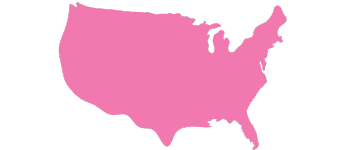Data highlight
Oklahoma ranks 40 (out of 50). Hawaii is #1, with the lowest percentage of women reporting symptoms of anxiety or depression at 24.3%. Mississippi has the highest at 43.8%.
HOW WE STACK UP
Women ages 18+ who report experiencing symptoms of anxiety and/or depressive disorder during the majority of the past 7 days.


Source: Kaiser Family Foundation
YOU MIGHT ALSO LIKE
Definition
Anxiety is excessive worry and fear, while depression is a deep and persistent feeling of sadness and hopelessness. Both conditions affect a person’s daily life and can be treated with professional help and support.
Why we care:
While all people feel worried or down from time to time, depressive and anxiety disorders can severely impair a person’s ability to carry on with their normal, daily life.
Women are twice as likely to be diagnosed with both making it an especially important issue for women’s health. The inequity is linked to biological, social, and cultural factors that cause higher distress in women.
Changes in hormone levels throughout a woman’s menstrual cycle and reproductive life probably play a large role, and women are especially prone to depression after giving birth (see Postpartum Depression).
Major risk factors for both anxiety and depression include Adverse Childhood Experiences (see ACEs Reported), sexual and domestic violence (see Sexual Violence, Intimate Partner Violence), all of which women are more likely to have experienced.
Poverty, homelessness, and incarceration also increase the likelihood that someone struggles with anxiety and/or depression (see Female Incarceration, Women Experiencing Poverty, Women Experiencing Homelessness).
While many still don’t take anxiety and depression as seriously as physical health concerns, the data show that women living with these conditions are at greater risk of developing heart disease and substance use issues and are more likely to attempt suicide than those without.
Despite the seriousness of mental disorders, appropriate screening and care remain hard to come by – especially for women who are poor, members of the LGBTQ+ community, and/or Black, Brown, or Indigenous.
Uninsured women are just over half as likely to have discussed mental health issues with a provider than those with health insurance. Black and Asian women are less likely than their white counterparts to touch on psychological well-being during a visit.
When women do report needing mental health support, they don’t always get it. Nationally, only half of women ages 18-64 who felt they needed mental health services in the last two years obtained an appointment.
What we can do:
- Work to improve social cohesion and support systems. Communities can provide a protective factor, increasing resilience in the face of stressful events.
- Improve telehealth and health communication technology so accessing counseling and non-emergency mental health services is easier and less expensive.
- Expand training programs for psychologists, psychiatrists, and other mental health professionals.
- Embed mental health professionals and social workers in primary care settings.
- Encourage mental healthcare providers to practice in Oklahoma by offering financial incentives (like loan repayment programs and signing bonuses).
- Promote training for primary care physicians to better detect and treat mental health.
- Provide universal screenings for mental health at the primary care level.
This issue brief was written by Metriarch staff as part of our Data Lookbook. Peer review was provided by Whitney Cipolla with Healthy Minds Policy Initiative.
Suggested citation
Metriarch. “Mental Health,” Data Lookbook (2024). URL: metriarchok.org/depression-and-anxiety.
- Last updated March 18, 2024
Share this page:



